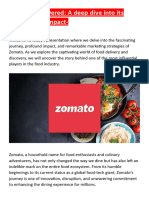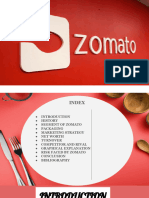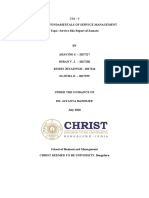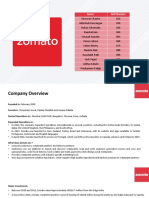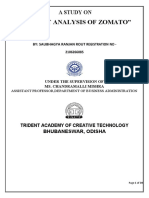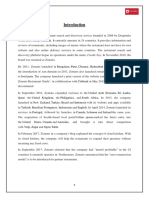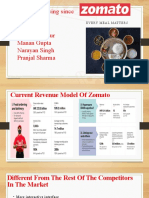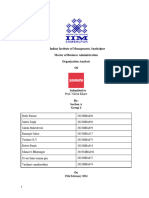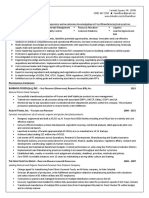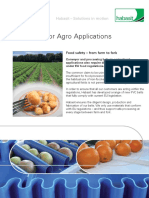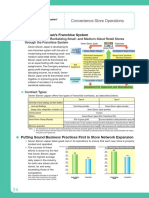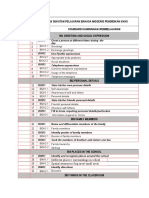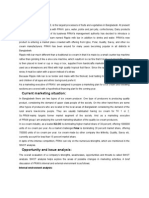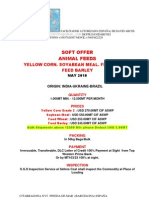A Study on Financial Analysis of Zomato Ltd
1. Introduction
1.1 Introduction
Zomato is a prominent Indian multinational company that has become a key player in the
global food service industry, providing a diverse range of services such as food delivery,
restaurant discovery, online ordering, and dining experiences. Established in 2008 by
Deepinder Goyal and Pankaj Chaddah, Zomato started as a small online restaurant discovery
platform aimed at offering users access to restaurant menus, photos, and reviews. The
company's founders saw a gap in the market for a centralized source of information on dining
options, and with a strong vision, they set out to transform the way people explored food and
restaurants in their cities. Initially focusing on Indian markets, Zomato’s reach quickly
expanded to other countries as it began to innovate and diversify its services.
Over the years, Zomato evolved from a simple restaurant directory to a comprehensive food
discovery and delivery platform. One of its key innovations was the introduction of online
food delivery services, which revolutionized how customers accessed meals from their
favorite restaurants. Zomato’s food delivery service enabled users to order food from
thousands of restaurants, while the company’s platform provided real-time tracking, secure
payment options, and efficient delivery systems. In addition to food delivery, Zomato also
introduced features such as table reservations, allowing customers to book dining experiences
directly through its platform.
In 2015, Zomato further expanded its offerings by launching Zomato Gold, a premium
subscription service that provides customers with exclusive discounts, offers, and promotions
at partner restaurants. This initiative helped drive customer loyalty while offering restaurant
partners increased foot traffic and visibility. Zomato’s commitment to providing value to both
consumers and businesses led to the creation of a dynamic ecosystem where restaurants could
enhance their online presence through Zomato’s reviews and ratings system, while consumers
enjoyed greater access to information and deals.
One of Zomato’s significant strengths has been its ability to leverage technology and data to
enhance its offerings. The company’s user-friendly app and website integrate sophisticated
1
�algorithms that recommend restaurants, provide personalized suggestions, and enable users to
track their orders in real time. Moreover, Zomato has continued to innovate by integrating
features like AI-powered chatbots and machine learning-driven personalized
recommendations, positioning itself as a leader in food technology.
Zomato’s growth has been marked by its successful expansions into several international
markets, including the United States, the United Kingdom, Australia, and the Middle East,
among others. The company has made several strategic acquisitions along the way, such as
the purchase of the UAE-based food delivery service, UberEats India, which helped solidify
its position in the competitive food delivery space.
Despite facing fierce competition in the global food delivery market, Zomato has
demonstrated resilience and adaptability. The company went public in 2021 with an IPO that
attracted widespread attention, further cementing its status as a major player in the tech-
driven food services industry. The IPO was an important milestone in Zomato’s journey,
reflecting investor confidence in the company’s business model and future prospects. Zomato
continues to focus on expanding its offerings, improving customer experience, and fostering
partnerships with restaurants to maintain its competitive edge.
Today, Zomato serves millions of users across the world and boasts a vast database of over
1.5 million restaurants. The company’s user-centric approach and its ability to adapt to
changing market demands have ensured that it remains a dominant force in the food delivery
and restaurant discovery space. Zomato’s vision of creating a more connected and accessible
food ecosystem has shaped not only the dining experience but has also had a significant
impact on the broader food-tech industry. Through its continuous innovations and
commitment to service excellence, Zomato is poised to continue playing a transformative role
in the way people experience food and dining in the years to come.
Foundational Overview
Zomato Limited is a pioneering digital platform that has fundamentally transformed the food
service and restaurant technology ecosystem in India and beyond. Established in 2008, the
company has evolved from a simple restaurant discovery website to a comprehensive food
technology enterprise that bridges restaurants, consumers, and innovative digital solutions.
2
�Legal and Corporate Details
Incorporation Date: July 18, 2008
Company Type: Public Limited Company
Listed On: Bombay Stock Exchange (BSE) and National Stock Exchange (NSE)
IPO Date: July 23, 2021
Global Presence: Operations in multiple countries across Asia and other regions
Founders and Leadership
Founding Team
Deepinder Goyal: Co-founder and Chief Executive Officer
o Background: IIT Delhi alumnus
o Visionary behind Zomato's technological innovation
o Instrumental in pivoting from restaurant discovery to a comprehensive food
technology platform
Pankaj Chaddah: Co-founder (until 2018)
o Played a crucial role in early-stage company development
o Contributed to strategic business model design
Current Leadership
Deepinder Goyal: CEO and Managing Director
Akshant Goyal: Chief Financial Officer
Robust Board of Directors with expertise in technology, finance, and global business
strategies
Business Model and Revenue Streams
Subsidiaries:
1. Blinkit (Acquired in 2022 – Formerly Grofers)
3
�Blinkit, formerly known as Grofers, is an online grocery delivery service that Zomato
acquired in 2022. The acquisition of Blinkit marked Zomato's entry into the quick-commerce
space, a fast-growing sector that promises ultra-fast deliveries of groceries and other
essentials. Blinkit operates on a model of delivering groceries and daily necessities to
consumers within minutes, typically within 10-20 minutes of placing an order, leveraging a
network of dark stores (micro-warehouses located close to high-density urban areas) to fulfill
the orders quickly.
The acquisition of Blinkit was a strategic move by Zomato to expand its business beyond
food delivery into a complementary vertical, capitalizing on the surge in demand for rapid
delivery of groceries and essentials. With Blinkit, Zomato aims to provide its customers with
a more comprehensive range of services, helping it tap into the growing demand for on-
demand, ultra-fast e-commerce solutions. As the demand for hyperlocal services grows,
Blinkit offers a valuable addition to Zomato’s portfolio, providing an avenue for increased
customer engagement and new revenue streams. The integration of Blinkit into Zomato’s
existing operations has allowed the company to further expand its logistics capabilities,
creating synergies that benefit both platforms.
3. Hyperpure (Launched in 2019)
Hyperpure is Zomato’s farm-to-table B2B supply chain platform that was launched in 2019.
Its purpose is to supply restaurants with fresh, high-quality ingredients directly from verified
and trusted suppliers, ensuring that restaurants can serve quality food to their customers. The
initiative aims to streamline the procurement process for restaurants by connecting them with
reliable vendors, cutting out the middlemen, and offering standardized pricing.
Hyperpure’s focus is on providing clean, sustainable, and high-quality ingredients while also
ensuring consistency and transparency for restaurant partners. It serves as an important part
of Zomato's broader vision to support the food service ecosystem by providing essential
supplies and helping restaurants maintain a high standard of food. By controlling the supply
chain of essential ingredients, Zomato not only creates a more efficient platform for
restaurants but also taps into a lucrative B2B market. Hyperpure plays a key role in
improving food quality, reducing waste, and ensuring that restaurants have access to the best
raw materials, which ultimately enhances the overall dining experience for consumers.
4
�4. Feeding India (Acquired in 2019)
Feeding India is a non-profit initiative acquired by Zomato in 2019 that focuses on addressing
hunger and food wastage across India. The platform works to connect surplus food from
restaurants, caterers, and households with people in need. Feeding India operates through a
network of volunteers who help deliver food to marginalized communities, orphanages, old-
age homes, and homeless shelters. The initiative also works on reducing food wastage by
redistributing food that would otherwise go to waste, ensuring it reaches those who need it
most.
Zomato's acquisition of Feeding India allowed the company to leverage its extensive network
of restaurants and logistics capabilities to scale up the food distribution efforts of the non-
profit. The partnership with Feeding India aligns with Zomato’s corporate social
responsibility goals, and it reflects the company’s commitment to making a positive social
impact by addressing hunger and food security issues. The initiative also serves as a powerful
tool for raising awareness about food wastage, highlighting the importance of sustainability
and responsible consumption within the food service industry.
By integrating Feeding India into its operations, Zomato has taken significant strides toward
contributing to societal well-being, ensuring that food that would otherwise be wasted is put
to good use. This initiative has earned Zomato recognition as a socially responsible company,
demonstrating that it is not only focused on business growth but also on its role in alleviating
social challenges.
Core Business Segments
1. Food Delivery Platform
o Digital intermediary connecting restaurants with consumers
o Comprehensive ordering and delivery ecosystem
o Advanced logistics and delivery management
2. Restaurant Discovery
o Detailed restaurant information
o User reviews and ratings
5
� o Menu catalogs
o Digital marketing solutions for restaurants
3. Digital Advertising
o Restaurant promotion services
o Targeted marketing solutions
o Digital visibility enhancement for restaurant partners
4. Subscription Services
o Zomato Pro membership
o Value-added services for frequent users
o Premium dining and delivery experiences
5. Cloud Kitchen Initiatives
o Backend infrastructure for restaurant operations
o Kitchen technology solutions
o Support for restaurant ecosystem innovation
Digital Ecosystem
Multi-platform accessibility
Seamless user experience
Advanced data analytics
Personalized recommendation engines
Market Positioning
Market Reach:
Domestic Market: Extensive coverage across Indian cities
International Presence: Operations in multiple countries
Active Restaurant Partners: 100,000+ restaurants
Monthly Active Users: Millions of digital platform users
Competitive Advantages:
First-mover advantage in restaurant technology
6
� Comprehensive digital ecosystem
Strong brand recognition
Continuous technological innovation
Data-driven decision-making
Financial Highlights
Key Financial Metrics:
Revenue Diversification
Consistent Investment in Technology
Strategic Growth Approach
Focus on Operational Efficiency
Investment and Funding
Multiple funding rounds from global venture capitalists
Significant investment from technology and venture funds
Successful public listing demonstrating market confidence
1.3 Objectives of the Study
The primary objectives of this financial analysis include:
- Analyze Zomato's financial statements from [2020] to [2024]
-To Determine the Profitability,Liquidity Ratios.
- Evaluate key financial ratios and their trends
- Provide strategic recommendations based on financial analysis
1.4 Scope of Study
Geographical Scope
- Primary focus on Zomato's operations in India
- Comparative analysis with international markets
- Comprehensive review of financial statements from [2020] to {2024]
Analytical Scope
- Detailed financial ratio analysis
- Revenue and profitability assessment
7
�- Operational efficiency evaluation
- Comparative market analysis
- Strategic financial insights
1.6 Research Methodology
Data Collection Methods
1. Secondary Data Sources
- Annual Reports
- Financial Statements
- SEBI Filings
- Investor Presentations
- Website
2. **Analytical Techniques**
- Ratio Analysis
- Trend Analysis
1.7 Period of Study
Duration: [2020] to [2024]
- Comprehensive analysis of financial statements
- Focus on key financial periods
- Inclusion of pre and post-IPO financial performance
2. Review of Literature
1. Zomato's Business Model and Revenue Streams
Zomato, founded in 2008, is a global food delivery and restaurant discovery platform.
According to Jha et al. (2021), Zomato’s revenue model primarily consists of three key
streams: (1) food delivery fees, (2) restaurant subscriptions, and (3) advertising revenue. The
company generates income from commissions charged to restaurants, delivery fees from
customers, and additional advertising revenue from restaurant partners promoting their
8
�businesses on the platform. Zomato’s revenue growth has been largely driven by its
expanding user base and geographic reach, along with technological advancements in order
processing and customer targeting (Reddy & Singh, 2022).
2. Financial Performance Pre-IPO
Zomato’s financial trajectory before its Initial Public Offering (IPO) showed rapid growth in
both revenue and operating losses. As noted by Gupta (2021), prior to going public, Zomato
was in a constant battle with its financials, primarily due to high operational costs, including
marketing, technology, and logistics. The company's loss-making nature raised questions
about its profitability, but its aggressive expansion strategy into new markets, along with
strong user engagement, positioned it as a major player in the Indian and global food tech
space (Krishna & Patel, 2021).
3. Post-IPO Financial Performance
Following its IPO in July 2021, Zomato’s financial performance has been the subject of
intense analysis. As reported by Sharma (2022), Zomato’s stock surged after its debut but
faced volatility due to broader market conditions. Analysts like Verma (2021) highlighted that
while the company showed strong revenue growth post-IPO, its path to profitability remained
uncertain. The company reported a substantial revenue increase of 72% in FY2022, but
continued to post losses, making its profitability a long-term concern for investors.
4. Revenue Growth and Profitability
Zomato has exhibited remarkable revenue growth over the years. According to data from
Zomato’s financial statements (2021), the company’s gross revenue crossed ₹2,700 crores
(approximately USD 360 million), reflecting a consistent upward trajectory. However, as
pointed out by Soni (2021), achieving sustainable profitability remains a challenge. Zomato’s
gross profit margin, while improving, was still low compared to global peers such as
DoorDash, which are able to leverage economies of scale in mature markets.
5. Cost Structure and Operating Expenses
A key aspect of Zomato’s financial analysis is its cost structure. In an in-depth report by Das
& Verma (2022), it was noted that delivery costs, which include last-mile logistics, account
for a significant portion of Zomato’s expenses. Furthermore, the company’s customer
acquisition costs (CAC) are high due to its heavy reliance on digital marketing and
9
�promotions to build a user base. Despite this, Zomato has been working towards streamlining
its operations and optimizing logistics to reduce these costs, particularly through partnerships
and the use of technology (Singh & Iyer, 2021).
6. Customer Acquisition Costs and Lifetime Value
In line with global best practices, Zomato focuses on balancing customer acquisition costs
(CAC) with customer lifetime value (LTV). Raghavan (2021) discusses how Zomato’s LTV
is highly contingent on retaining customers and increasing their spending per order. The
company has invested heavily in loyalty programs and discounts to enhance user retention.
However, there remains a concern about whether the LTV is high enough to justify the steep
customer acquisition costs (Zhao & Gupta, 2021).
7. Gross Merchandise Value (GMV)
GMV, an important metric in the online food delivery industry, measures the total value of
orders placed through Zomato’s platform. According to Zomato’s 2021 investor report, its
GMV reached approximately ₹14,000 crores (USD 1.8 billion) in FY2021, indicating strong
order volume. Research by Nair & Rao (2022) suggests that GMV has been a key indicator of
Zomato’s market presence and growth, correlating closely with revenue generation.
8. Competitive Landscape and Financial Implications
Zomato competes with Swiggy, Uber Eats, and other local players in the online food delivery
market. Studies by Khanna & Kumar (2021) show that while Zomato holds a leading market
share in India, Swiggy's superior delivery network and diversified business lines (e.g., cloud
kitchens) put pressure on Zomato’s market dominance. Moreover, DoorDash’s financial
performance in the U.S. (with higher profit margins) poses a benchmark challenge for
Zomato (Mohan & Sood, 2021).
9. Impact of COVID-19 on Zomato’s Financials
The COVID-19 pandemic had a significant impact on Zomato’s financial performance. As
highlighted by Aggarwal (2021), the lockdowns and surge in demand for home delivery
services temporarily boosted Zomato’s order volumes. However, the subsequent economic
slowdown and changing consumer behavior posed long-term challenges. Despite this,
Zomato adapted quickly by introducing contactless delivery and expanding into grocery
delivery, which provided additional revenue streams (Singh, 2022).
10
�10. Future Prospects and Investment Strategy
Looking ahead, Zomato’s future financial performance will depend on its ability to scale its
operations while managing costs effectively. As discussed by Chawla & Bansal (2022),
Zomato’s aggressive expansion strategy in emerging markets, coupled with investments in
technology and data analytics, is expected to drive future growth. However, the company
must also contend with rising competition, economic uncertainties, and regulatory challenges
in its key markets.
Conclusion
The financial analysis of Zomato reveals a company that has demonstrated impressive
revenue growth but continues to face challenges in achieving consistent profitability. Despite
high operational costs and significant losses in the short term, the company’s long-term
prospects are tied to its ability to leverage technological innovations, optimize costs, and
expand its footprint in new markets. The company’s financial outlook will largely depend on
its ability to balance customer acquisition costs with long-term value creation, and on how
well it can navigate competitive pressures and external market conditions.
1. Overview of the Study
The project, titled "A Study on Financial Analysis of Zomato Ltd," aims to evaluate the
financial health and performance of Zomato Ltd, a leading player in the food delivery and
restaurant aggregation industry. This study uses financial metrics, ratio analysis, and trend
analysis to provide insights into the company's operations, profitability, liquidity, and overall
sustainability in the competitive market.
1.1 About the Study
This study focuses on understanding Zomato's financial dynamics over a defined period. It
analyzes the company’s key financial statements, including the Balance Sheet, Profit and
Loss Statement, and Cash Flow Statement, to evaluate its financial performance.
Additionally, the study investigates Zomato's revenue model, market strategies, and its
position in the industry, while identifying factors contributing to its growth and challenges.
11
�1.2 History
Zomato Ltd has had an impressive journey from a small startup to becoming a global food-
tech giant. Here's a detailed look into its history:
2008: Founding and Initial Concept Zomato was founded as Foodiebay by Deepinder Goyal
and Pankaj Chaddah in Gurugram, India. The idea originated when they noticed high demand
among their colleagues for physical copies of restaurant menus.
Foodiebay started as an online platform that provided scanned copies of restaurant menus,
helping users discover eateries.
2010: Rebranding to Zomato
The company rebranded itself to Zomato to create a global identity and expand beyond Indian
borders. The name “Zomato” was chosen for its catchy and relatable appeal in various
markets.
2011-2013: Expansion within India
Zomato expanded rapidly across major Indian cities, listing thousands of restaurants and
introducing user-generated reviews and ratings. It became a trusted platform for discovering
restaurants, offering detailed menus, photos, and contact information.
2012-2015: International Expansion
Zomato began its international journey by entering markets like UAE, Sri Lanka, Qatar, the
UK, South Africa, New Zealand, and the Philippines. The company also acquired several
international startups, such as:
MenuMania in New Zealand
Lunchtime.cz and Obedovat.sk in the Czech Republic and Slovakia
UrbanSpoon in the USA (2015), strengthening its presence in North America.
12
�2015-2018: Transition to Food Delivery
Zomato pivoted to food delivery services to compete with emerging players like Swiggy in
India and Uber Eats globally. The introduction of a robust delivery network marked a
significant shift in its business model. Launched services like Zomato Pro (later rebranded to
Zomato Gold), offering exclusive dining and delivery discounts to subscribers.
2018-2020: Strengthening Operations
Acquired TongueStun Food, a B2B food-tech company, to expand its corporate offerings.
Introduced Hyperpure, a B2B marketplace providing high-quality ingredients to partner
restaurants. Focused on sustainability initiatives, such as reducing plastic usage and
promoting eco-friendly packaging.
2020-2021: Navigating the Pandemic
During the COVID-19 pandemic, Zomato adapted by:
Launching Zomato Market to deliver groceries.
Providing free meals to healthcare workers and the underprivileged.
Supporting restaurants with financial aid and operational guidance.
The pandemic accelerated its delivery business, contributing to its revenue growth despite
challenges.
2021: Initial Public Offering (IPO)
Zomato became one of the first Indian food-tech companies to go public. Its IPO was highly
successful, raising ₹9,375 crores (approximately $1.3 billion) at a valuation of around $12
billion.
The IPO marked a milestone, with Zomato being listed on the National Stock Exchange
(NSE) and Bombay Stock Exchange (BSE).
2022-2024: Post-IPO Growth and Strategic Moves
13
�Zomato acquired Blinkit (formerly Grofers) to enter the quick-commerce segment, delivering
groceries and essentials in under 15 minutes.
Continued investments in AI, logistics, and customer experience optimization.
Focused on profitability by streamlining operations and reducing cash burn.
Current Status:
As of today, Zomato is a leading name in the food delivery and restaurant aggregation
industry.
It operates across multiple verticals, including food delivery, B2B restaurant supplies, and
quick commerce. The company continues to innovate and adapt to market trends, maintaining
a significant presence in India and select global markets.
Zomato’s journey reflects its adaptability and determination to stay relevant in a competitive
and dynamic industry.
1.3 Reaches
Geographic Reach: Zomato serves in India and operates in select international markets like
UAE, Australia, and Singapore.
Market Segments:
Food Delivery: Connecting restaurants with customers through an app.
Restaurant Discovery and Reviews: Comprehensive restaurant listings with user-generated
reviews and ratings.
B2B Services: Includes Hyperpure (supply chain for restaurants) and Zomato Pro
(membership program for customers).
Digital Reach: With over 70 million monthly active users in India, Zomato remains one of
the most downloaded food apps.
1.4 The Activities
Core Business Operations:
Food Delivery: Partnering with restaurants to deliver food to customers.
14
�Restaurant Discovery: Enabling users to explore restaurant menus, photos, reviews, and
ratings.
Membership Programs: Offering subscription services like Zomato Pro for discounts on
dining and delivery.
Logistics: Managing a network of delivery personnel to ensure timely deliveries.
B2B Services:
Hyperpure: Supplying fresh and hygienic ingredients to restaurants.
Technology: Investing in AI and data analytics to enhance customer experience, optimize
delivery routes, and improve restaurant operations.
Corporate Social Responsibility (CSR):
Initiatives like feeding underprivileged communities during the COVID-19 pandemic and
reducing food waste.This overview provides a foundation for analyzing the financial
performance of Zomato Ltd and its impact on the industry.
3.5 The Products
- Food Delivery Services
- Restaurant Discovery Platform
- Zomato Pro Membership
- Advertising Solutions
- Cloud Kitchen Initiatives
3.8 Competitors
- Swiggy
- UberEats
- EatSure
- Other Regional Players
- International Competitors
15







